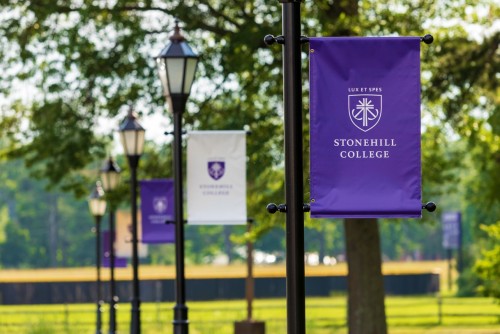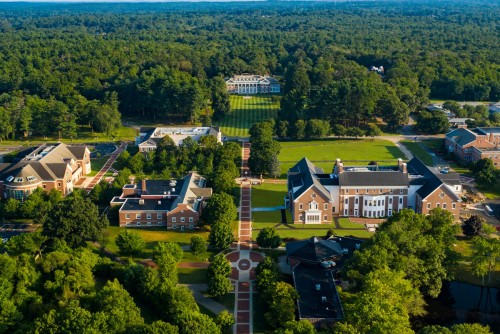The Space to Explore
Professors receive three coveted NASA grants for innovative work in their varied fields of study.
Landing a NASA research grant is a major academic accomplishment for any institution, so Stonehill College administrators were delighted when they learned that three such grants had been awarded to faculty in the departments of physics, astronomy and chemistry.
“I’ve been at Stonehill for 20 years, and this year represented our first attempts to secure NASA funding, so to have faculty receive three grants in a similar time frame is outstanding,” says Bonnie Troupe, director of the Office of Research, Grants and Sponsored Projects. “It not only speaks to the caliber of research being done at Stonehill but also showcases the strength of our faculty and their ability to build relationships within the larger research community.”
Deepening Our Understanding of Black Holes
In just her second year at Stonehill, Assistant Professor of Physics and Astronomy Francesca Fornasini secured a grant to continue her research on black holes and other extreme objects with very strong gravity. “This grant is associated with new observations taken by two X-ray telescopes: XMM-Newton, which looks at low-energy X-rays, and the Nuclear Spectroscopic Telescope Array (NuSTAR), which looks at high energy X-rays,” says Fornasini. The telescopes have been taking pictures of a nearby galaxy with intriguing properties. “The galaxy has a low chemical abundance that closely resembles galaxies in the very early universe, so this research allows us to gain a sense of what the black hole population might have looked like in that time period.”
Fornasini outside the Merkert-Tracy observatory.
Fornasini notes that astronomy can be a gateway science for students because it easily piques their curiosity. Extreme astrophysical objects can be examined using the same principles that govern everyday objects. “I find astronomy research intrinsically exciting because it works to address our understanding of our place in the universe,” she said. “It’s a way of working out our history in a much bigger context than even human history.” Adding to its appeal, she said, is that the knowledge and skills that students learn by doing astrophysics research can be applied to a wide range of scientific problems.
Supporting Undergraduate Access to Photonics
Through her collaborations with Applied NanoFemto Technologies LLC, Associate Professor of Physics Guiru Gu received support for the AIM Photonics LEAP@Stonehill (Lab for Education and Application Prototypes), the college’s state-of-the-art photonics lab. “These funds will be very helpful in providing supplies and support to run the lab, which is quite costly to operate,” says Gu. “Stonehill is one of the few colleges in the country to offer undergraduates a degree in photonics, and our lab gives them valuable hands-on training in the field.” The grant also reflects Stonehill’s significant role in furthering the federal government initiatives designed to support technology development and commercialization for small businesses, Gu observes.
Associate Professor of Physics Guiru Gu’s NASA grant supports Stonehill’s state-of-the-art photonics lab.
Exploring Life's Origins Via Deep-Sea Research
Associate Professor of Chemistry Daniel Rogers has been awarded a subcontract to continue his research into microscopic forms of life in California’s Santa Barbara Basin, a low-oxygen environment that’s intriguing for its similarities to early Earth and perhaps beyond. “Fish can’t survive without oxygen, but microscopic organisms called foraminifera or forams can. The question is how. With colleagues at the Woods Hole Oceanographic Institution and Harvard University, we are examining potential symbiotic relationships between the foram and bacteria that live inside them,” Rogers explains. “By studying these symbiotic relationships, we can gain a deeper understanding of that transitional space between less complex life (think bacteria) in an environment without oxygen and more complex life (think plants and animals) in an oxygen-rich environment. This in turn helps us to understand how life derives energy from its environment.”
Associate Professor of Chemistry Daniel Rogers’ NASA grant helps him to continue his research into microscopic forms of life in California’s Santa Barbara Basin, a low-oxygen environment that’s intriguing for its similarities to early Earth.
Rogers’ lab members are active field researchers, work that occasionally calls for a week aboard a research ship, as in this study. “Conducting research in the field, especially in the deep-sea realm, is an opportunity that few undergraduates get,” he notes. “Students come away with a better understanding of the challenges and rewards of fieldwork and discover the real-world application of things they learn in the classroom. It opens their eyes to the possibilities that are available to them and shows them, ‘This is where you put your knowledge to work, and this is also where you have the opportunity to add something to the body of knowledge.’”
Woods Hole Oceanographic Institution is the partner in this collaborative research project that is funded through the Research Opportunities in Space and Earth Science program of NASA.
Related
-
Request Information
Sign up now to be added to our mailing list, and we will show you how Stonehill could become part of your story.
-
Visit Opportunities
Our visit programs will help give you a better understanding of how Stonehill’s expansive leadership and experiential learning opportunities equip students for success in a rapidly evolving and globally competitive world.
-
Apply for Admission
Stonehill College provides an exceptional learning experience for both undergraduate and graduate students. We invite you to review the process, requirements and application deadlines for our entry options.


